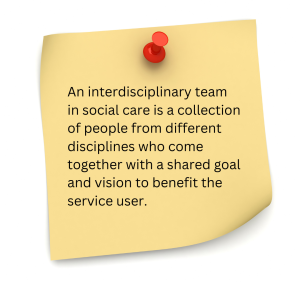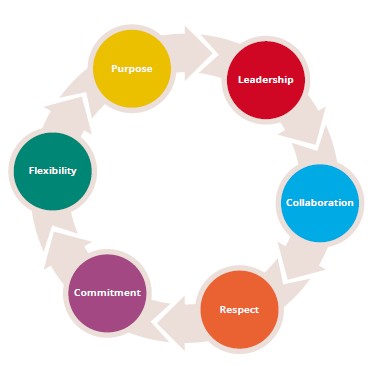Chapter 37 – Gráinne Powell (D2SOP14)
Domain 2 Standard of Proficiency 14
Understand the role and impact of effective interdisciplinary team working in meeting service user needs and be able to effectively contribute to decision-making within the team setting.
|
KEY TERMS Interdisciplinary teams An interdisciplinary response Ingredients for success
|
Social care is … a worthwhile and fulfilling profession, filled with possibilities. The social care profession thrives on innovation and creativity. It is ever evolving. The cornerstones of social care are empathy and commitment. It’s a profession that is built on relationships and a therapeutic environment. |

Multidisciplinary: Staff from different disciplines working together, each member representing their own discipline and bringing their professional knowledge and expertise to the team. Generally creating discipline specific care plans.
Interdisciplinary: An integrated approach to working, sharing, resources and learning from the expertise within and across the team. Sharing responsibility and making joint decisions.
Interdisciplinary Teams
Interdisciplinary teamwork is a common practice across the social care settings. It involves different types of staff working together to share their skills, expertise and knowledge. Working in interdisciplinary teams gives service providers the ability to pool their resources and provide a holistic package of supports to service users. Terms such as intradisciplinary, interdisciplinary and multidisciplinary are used interchangeably to describe collaborative team working. However, there are some distinct differences. Inter/multidisciplinary teams are generally broader than intradisciplinary teams and involve staff from different professional backgrounds working together. Other teams in the social care area are made up of staff from single disciplines working in an integrated way using open communication to share ideas and make decisions.
An Interdisciplinary Response
The issues that impact on the lives of families and communities are often complex and varied. The uniqueness of individuals and the impact of their circumstances must be accounted for when responding to them. This often requires a myriad of approaches and resources to meet specific needs. No one agency or discipline has all the expertise and resources to meet the needs of the individuals we work with. While upholding the ethics and integrity of our agency, we strive to blend a response for the greater good of the service user. However, success does not ‘just happen’ because services pull together. It is usually the result of a substantive investment of skills, resources and time to ensure that all members of the team work well together. By pooling our resources and providing a holistic and integrated response, we can do so much more that we can on our own.
Lalor and Share (2013) describe how the social care profession is ultimately concerned with the delivery of high-quality professional care to adults and/or children with health and social care needs. The underpinning principles that guide us in our work in social care, such as building respectful client interactions, help us to listen more deeply and understand more compassionately when advocating for and on behalf of others. A core aim in social care is to empower individuals to develop the resources required to overcome adversity in their lives. This special emphasis on the capacities of individuals in meeting their own social care needs frames how the social care worker highlights and addresses needs within the interdisciplinary team. Focusing on strengths and resources and empowering service users to access their internal supports builds self-belief and strengthens coping mechanisms. The worker and the service user work in unison to address concerns and seek out solutions that will meet real needs.
All members of interdisciplinary teams are selected on the basis of their relationship with the service user. Social care practitioners play a very valuable role on interdisciplinary teams due to the ‘hands on’ nature of the work. Social care practitioners work alongside service users in a non-judgemental way that gently supports growth and development. Our role with service users is to offer care and support in a safe, trusting environment. The empathy and understanding that is fostered in social care relationships means that the social care worker gains an insightful knowledge of service users that many other professionals at the interdisciplinary table may not have. This knowledge, based on respectful everyday interactions, strengthens solutions by placing a practical, person-centred lens on them. So never underestimate the value of the social care practitioner’s contribution to the interdisciplinary team. It is rich in insight and offers a fresh relational approach to meeting the real needs of families and communities.
Ingredients for Success
The functionality of any group depends on a having a few important things in place. Because the interdisciplinary group embraces a collection of people from different backgrounds, there may be conflicting organisational cultures, agendas and values. Working towards a shared goal requires compromise and setting aside organisational differences. Having terms of reference and guidelines in place can prevent conflict and ensure that goals are met. Every group needs a well-defined purpose. This gives clarity and focus so that everyone involved knows what is expected of them as a team member, and what success would look like. Good leadership, along with clear roles and responsibilities, will also make the team more efficient and focused. Having committed members who want the best outcome for all involved is a crucial marker for success, as it propels the group to think outside the box, to be creative, insightful and flexible in seeking the best solutions.
Purpose
Any interdisciplinary team must have a clear purpose. All too often, groups and teams are formed without a clear purpose, which can lead to feelings of frustration at their lack of direction and progress. It can also make members of the team feel insecure and unsure about their role on the team and doubt the value of the group. The purpose of the team should be clearly outlined and some measures for success should be noted from the onset so that progress and achievements can be monitored and evaluated on an ongoing basis.
Reflection
Think of a group, team or committee you have been involved with. It could be a sports team, a school committee, maybe even an event or party planning group. Think about these questions:
- What was the purpose of the group?
- What helped get things done?
- What strategies were used to keep everyone focused?
- What didn’t work well?
- What would you do differently?
Leadership
Leadership in interdisciplinary teams keeps the momentum and integrity of the group in place. It adds structure to the team by ensuring that timeframes are met and decisions are made. Strong leadership will strengthen interdisciplinary team work by encouraging equal participation in the process. It should drive the team forward to overcome barriers, to build connections and to seek out success.
Roles: Respect and Understanding
It’s not always easy to work together, especially when the values and expectations of organisations are so varied. However, if respect is expected from the outset and if there is an understanding of how other agencies operate, a way forward can be achieved in the best interest of service users. This appreciation for other styles and approaches to supporting individuals will make the information-sharing and decision-making processes more fluid and genuine. A successful interdisciplinary group is one where the individuals are valued equally for their insights and contributions. Less experienced members should be given opportunities to ask questions in the team. This often brings fresh perspectives and learning for all team members. Working together to achieve a shared agenda requires actively listening to colleagues so that opinions and thoughts are heard and mutually respected. Successful teams build on the strengths of each individual member.
Flexibility
Interdisciplinary teams need to have an element of flexibility to get things done. When working with people and for people we must be mindful that people react differently to the same situations, change is difficult, need is complex and one size does not fit all. With all this in mind, meeting the needs of service users requires a flexible approach and a collective response.
Commitment
Working together can be challenging, but a committed team who are working towards a shared goal will make the process more focused and productive. Committed team members will take their responsibility more seriously; they will follow up on issues and will work to find solutions to overcome barriers and obstacles. It’s important to reflect on the motivation behind interdisciplinary teams and to think about the most desirable outcomes and practical steps needed to achieve them.
Language
Language is very important in social care and we need to be mindful of how our language is received by others. All agencies and services use terminology familiar to their own disciplines. The language we use every day with our peers becomes familiar and comfortable to us; however, it may not be widely understood outside our own circles. When we work collaboratively it’s important to explore and discuss the different terminologies and interpretation attached to them across services. It is then useful to agree and outline the terms to be used for the purpose of the team.
Personal Reflection
Having spent most of my career in the health service, I am extremely conscious of how easy it is to fall into the ‘language trap’. The use of abbreviations and terminology that are not widely familiar outside your organisation can alienate interdisciplinary partners. I have found from my experience in delivering training, facilitating groups and participating in interdisciplinary teams that the more relational and plain I keep my language, the more tuned-in people are. We don’t need to embellish our points or use jargon. Be present, be clear and ask for clarity if you don’t understand something. Someone else will probably be relieved that you asked! Setting a tone of inclusivity and clarity is essential for good communication in interdisciplinary teams.
Collaboration
It will not always be possible for a single agency or individual to bring about change. Time is spent during the initiating phase of an interdisciplinary team in agreeing who needs to be involved. This decision is based on previous connections to the service user and possible new sources of support that may be beneficial. Then, the process of deciding what needs to be done, how it needs to be done and when it needs to be done can take place in a collaborative and inclusive way to maximise impact and outcomes. Interdisciplinary teams rely on service providers and service users working together as a collaborative team to set goals. Sharing responsibility across the team while also respecting the individual team members’ autonomy and expertise will generate a collaborate approach to supporting service users.

Interdisciplinary Teams
Benefits of an Interdisciplinary Approach
The benefits of interdisciplinary teamwork are substantial for service providers and service users. They have the ability to improve the overall effectiveness of services provided to children and families in the community. They can enhance the services offered by improving work practices and creating a one-stop shop for sharing expertise, exchanging ideas and pooling resources. The generation of creative ideas and alternative perspectives can inspire new methodologies for managing complex issues. Interdisciplinary teamwork prevents the duplication of services and assessments by bringing together the key people involved in the lives of service users to give their input to plans and make decisions.
Regular meetings can also improve the relationships and communication between different disciplines. This leads to higher levels of innovation and a joined-up approach to care. Many times in the past, service users sadly fell through the net and were not protected due to a lack of co-ordination and communication between the people involved in their lives. If services talk to each other, share resources and think how they can jointly support service users, time can be saved and more robust, sustainable outcomes can be achieved.
|
TOP TIPS FOR ENGAGING IN INTERDISCIPLINARY TEAMS |
|
Ask for clarification on the purpose of the meeting. |
|
Learn about the terms of reference, decision-making processes and the general running of the group. |
|
Be prepared. Arrive on time, read over notes and minutes and have your paperwork organised. |
|
Know what your service can contribute and what the limitations are. |
|
Be comfortable and content in your appearance. |
|
Express your views and be assertive in making your points. |
|
Keep an open mind and listen to the opinions and suggestions of others. |
|
Be clear and concise in your communication. |
|
Make connections, try to get to know other members of the team. Peer support is an invaluable asset in social care. |
|
Be confident in your ability to bring solutions and offer insight. |
|
Ensure an agreed framework for evaluating and reviewing the team purpose and productivity. |
|
Use supervision sessions to reflect on your personal progress and seek out new ways to be more effective. |
Questions to consider……
What does the social care practitioner bring to the interdisciplinary team?
What, do you think, are the barriers to interdisciplinary team working?
How can these barriers be overcome?
![]() Tips for Practice Educators
Tips for Practice Educators
This proficiency will require students to have an understanding of how to engage and participate in interdisciplinary teams. It is important that the student is afforded the space to reflect on what makes teams successful and the value of the social care contribution. Time spent unpacking interdisciplinary team success and the drivers of success as it relates to the service will develop the students’ understanding of interdisciplinary teamworking in a very real and tangible way. The practical aspects of participation and engagement, such as preparation and presentation, should be discussed as they are modelled through the placement. It’s important that the student is exposed to the level of preparation, the attention to relationships and the follow-up required in interdisciplinary teamwork. The finely tuned professional will often make the work look effortless and seamless, so getting students involved in preparation and collaboration before and after will be extremely useful. Encouraging the student to link actions to policy and theory will also help them to place the actions in context. Sharing agency reports and guiding national/international documents with the student will strengthen their learning for future practice.
Taking part in meetings generally will provide the student with the opportunity to view different perspectives from services and families. It will also give the student the invaluable opportunity to practise with the support of a supervisor in a safe environment, to articulate responses and to receive critical feedback. It may not always be appropriate for the student to actively participate in interdisciplinary team meetings; however, time spent reflecting and documenting what went well, how decisions were made and what outcomes were achieved will help the student to focus on the skills and techniques involved. Assigning practical tasks pertaining to the set-up of meetings and follow-up with services and families will increase the student’s participation in the dynamic of collaborative teamwork. A practical and solid piece of work for the student could involve the collation of a community needs assessment to gain insight into the workings of the different disciplines involved in the lives of families and communities. In exploring and examining the needs of communities, the allocation and co-ordination of resources will be better understood.
Students often have fresh and enlightened perspectives on the complexities of social care circumstances. Giving the student the opportunity to share their thoughts and creativity while encouraging them to shape these ideas in light of the community circumstances, resources, services and guiding documents will focus their application of theory to practice. Feedback and the use of reflective practice will help the student to sharpen their preparedness and their expertise through active participation and reflection. Asking the student to consider their strengths and the challenges they encounter, in relation to working as part of a team in their everyday life, combined with their practice experience, will help them to identify progression pathways.
References
Lalor. K, and Share, P. (2013) Applied Social Care: An Introduction for Students in Ireland. Dublin: Gill and Macmillan

